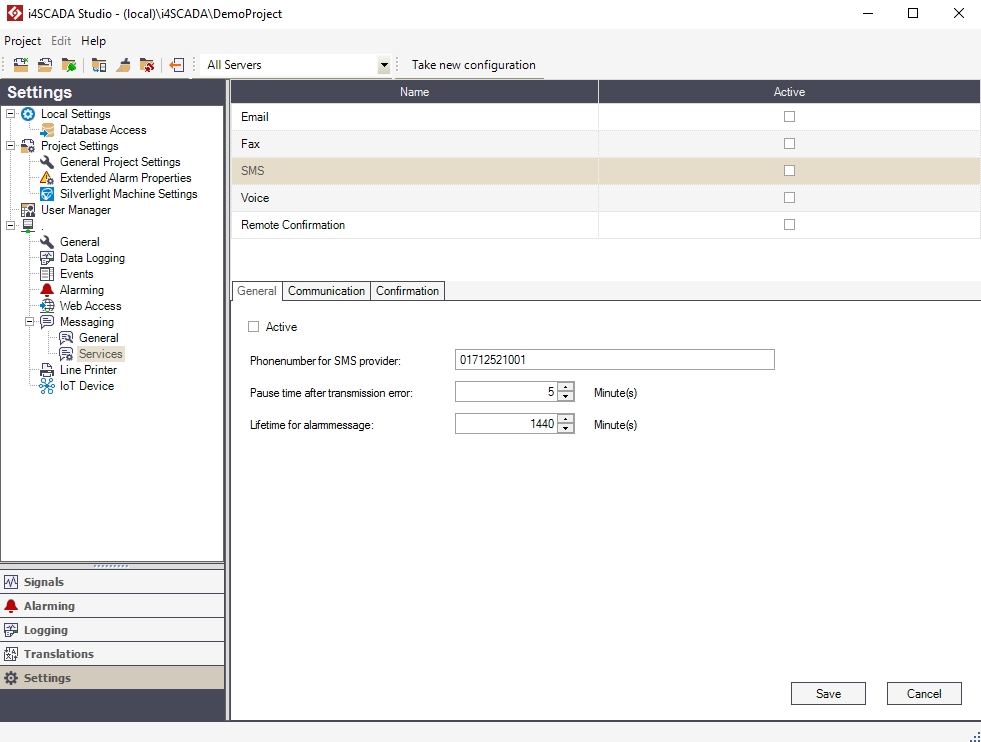SMS Messaging Service Section
Check out this article for details concerning the WEBfactory 2010 SMS Messaging Service configurations and settings.
The SMS Messaging Service section allows the user to configure the settings for sending SMS alarm messages with Messenger or MessengerPro.

The SMS Messaging Service section
The options listed in the SMS Messaging Service section are split in three categories: General, Communication and Confirmation.
The settings will only be saved upon pressing the Save button.
General options
UI Option | Description |
|---|---|
Active | Toggles the SMS messaging service on or off. If disabled, the SMS service won't be available in Messenger or MessengerPro. |
Phone number for SMS provider | The SMSC (Short Message Service Centre) number required to send SMS messages via the chosen provider.
|
Pause time after transmission error | The period of time (in minutes) to wait before sending again the alarm SMS, if an error was encountered when sending it initially. |
Lifetime for alarm message | The life time (in minutes) for an alarm SMS, in case of a persistent transmission error. The SMS message will be deleted from the system after this time passes. |
SMS Providers
Below, you will find a table with the dial-up numbers of various SMS providers. Please ask your provider for information concerning current dial-up numbers.
Please note: Forwarding an SMS into a foreign provider network (e.g. from D1 to E-Plus) is not supported by all providers.
Providers
Numbers
D1
01712521002 (analogue)
01712521001 (ISDN)
D2
01722278025 (analogue)
01722278000 (ISDN)
E-Plus
01771167 (analogue/ ISDN)
Anyway
The provider supports SMS forwarding into all networks
090032669002
Protocol type: UCP
Communication options
The Communication options allows the user to choose and configure the Exchange service or the Device settings for sending the alarm SMS.
Device
In this communication mode, the alarm SMS messages are sent using a modem, a CAPI device or a GSM device.

UI Option | Description |
|---|---|
Dial prefix | The prefix required to be dialed in order to send the alarm SMS, if the receiver is using a different provider or needs a country/region prefix to be called. |
Extension | If enabled, the receiver will be dialed directly, without checking for dial tone. |
Hardware interface | The hardware interface used for sending the alarm SMS. Can be:
|
Timeout | The the period of time to wait before redialing, when the receiver cannot be reached. |
Modem settings

UI Option | Description |
|---|---|
Protocol type | The protocol used by the SMS provider for sending the SMS messages. Can be:
|
COM port | The COM port used to access the modem. |
Dial method | The dial method of the modem: Tone or Pulse. The preferred dial method is Tone! |
Transfer rate | The rate of transfer between the computer and the modem. Please read the modem documentation to find out the recommended transfer rate. For newer modems, the MAX setting can be used. |
Additional AT-commands | If the modem requires additional AT (Hayes) initialization commands, they can be entered here. The AT commands will be sent to the modem before a connection is established. |
CAPI hardware interface settings

UI Option | Description |
|---|---|
Protocol type | The protocol used by the SMS provider for sending the SMS messages. Can be:
|
CAPI interface | The CAPI interface to be used, from 0 to 7. If you don't know which CAPI interface to select, please ask your hardware vendor/manufacturer. If you have only one ISDN card installed, try the CAPI interface 0. |
GSM hardware interface settings

UI Option | Description |
|---|---|
SMS Mode | The SMS format. Can be:
Both PDU formats are used when sending compressed or binary data. |
Transmits SMS header in PDU format | Sends the SMS user data header using the PDU format. The header specifies how the SMS should be formatted and processed. |
Use default AT commands | Uses the default Hayes AT command parameters for SMS. If disabled, AT commands used by default by the GSM device will not be transmitted. |
COM port | The COM port used to access the GSM modem. |
Transfer rate | The rate of transfer between the computer and the GSM modem. Please read the modem documentation to find out the recommended transfer rate. For newer modems, the MAX setting can be used. |
AT init command | The AT command used for initialization, if the modem requires this command. |
AT deinit command | The AT command used for deinitialization, if the modem requires this command. |
Confirmation options
The Confirmation options allows the configuration of the SMS message replies and feedback notifications.

UI Option | Description |
|---|---|
Active | If enabled, the system will check for incoming replies to the alarm SMS message. If disabled, the user will not be able to issue any command (e.g. confirmation or acknowledgment) via SMS reply. |
Polling interval | The time interval (in minutes) between two consecutive queries for replies to the alarm SMS message. |
Notification: Successful confirmation | The feedback notification that will be sent back to the user if the command sent by the user when replying to the SMS (e.g. confirmation or alarm acknowledgment) was successfully executed. The user has the possibility to edit the following options for the success confirmation:
|
Notification: Error occurred | The feedback notification that will be sent back to the user if an error occurred while executing the command sent by the user when replying to the SMS (e.g. confirmation or alarm acknowledgment). The user has the possibility to edit the following options for the error notification:
|
Notification: Invalid request | The feedback notification that will be sent back to the user if the command sent by the user when replying to the SMS (e.g. confirmation or alarm acknowledgment) is invalid. The user has the possibility to edit the following options for the invalid request notification:
|